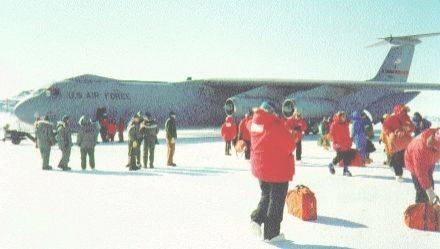
Aircraft

These people are getting off a C141 "Starlifter". While a military transport, this aircraft is comfortable so long as you're not packed like sardines as we were on the canvas bench seats. Any flight in the Antarctic requires that bulky Extreme Cold Weather clothing (E.C.W's) be worn. No clothing , no flight
It takes 5.5 to 6 hours, depending on wind direction and speed, to get from Christchurch, New Zealand, to the Ice Runway near McMurdo Station. If you actually get to Antarctica, (I say that because if the weather's bad planes are returned to NZ without landing if they have enough fuel make the trip) you will find you don't need all that clothing because the weather is usually good, but you never know, and its better to be safe than sorry. The C141's are used at Winfly if the Pegasus runway is operational.
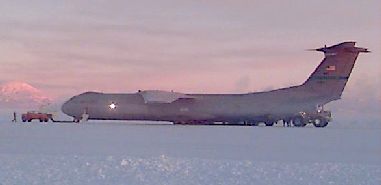
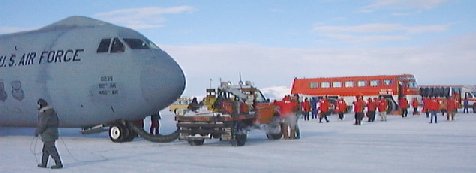
C141 and C5 at Winfly The first flights of the season and are called Winfly, short for winter flights, because they are the first flights allowed down straight after the 8 months of winter. They only have enough flights (about 4 or 5), to allow preparation of the Bases for the influx of activity due in the month after the Winfly period is over. They bring in the extra crew and stocks required to clear runways prepare food, recommission accommodation buildings... etc... etc.
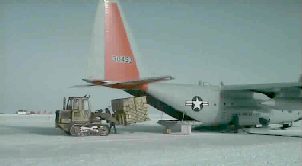

C130 loading and Deep field planes Deep field parties often use small aircraft for getting in and out of remote places that the helicopters don't have the range to get in and out of. These little aircraft suit the purpose very well. New Zealand doesn't not use them but Americans do.
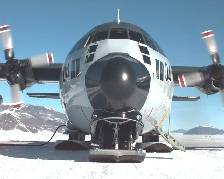
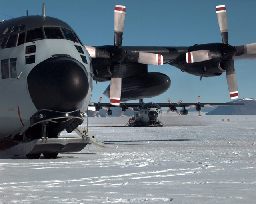
This is a C130 "Hercules". This is the workhorse of the Antarctic airways. Its loading, fuel and speed capabilities are nowhere near that of the C141. However, its Short Take Off and Landing (STOL) performance and the ability to be fitted with skies gives it greater versatility. These are used throughout the season on all three runways and also fly to Deep Field Camps and the South Pole. A C130 flight from Christchurch to McMurdo takes about seven hours or up to nine hours when equipped with skis (because of the extra drag).
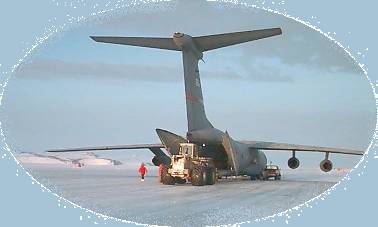 This is the C141 from behind on the sea ice
runway. Passengers are loaded from the front of the aircraft and
cargo from the rear. Over winter the sea ice freezes up to two
meters thick. When extra staff arrive at Winfly (the first series
of flights after winter, during August) they get out there with
the big machinery and literally plane the ice. They groom a
smooth runway out of the sea ice. This is similar to what they do
with indoor skating rinks but on a much bigger scale.
This is the C141 from behind on the sea ice
runway. Passengers are loaded from the front of the aircraft and
cargo from the rear. Over winter the sea ice freezes up to two
meters thick. When extra staff arrive at Winfly (the first series
of flights after winter, during August) they get out there with
the big machinery and literally plane the ice. They groom a
smooth runway out of the sea ice. This is similar to what they do
with indoor skating rinks but on a much bigger scale.
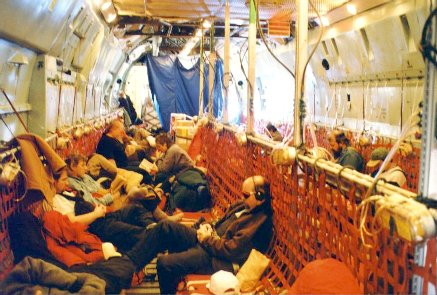
This is what it looks like on the inside of the C141 Starlifter. Notice all the web seating on both sides of the plane and down the end behind the blue tarpaulin there is a Pee barrel for the gents to ease a tight bladder. Down the other end of the plane there is a toilet for the ladies. The plane ride home is not normally cramped to tight people and have a chance to stretch out a bit. This is not normally the case for those that are going 'down' to Antarctica. Imagine the same scene with no legroom, everyone in full antarctica clothing and then imagine sitting like that for about 5 hours if your in a Starlifter, and about 8 hours if your in a Hercules. But that's not the worst !!, now think how you would feel if the plane struck bad weather and had to turn around after already being in the air for 5 hours. These are just some of the joys of flying 'Air Antarctica'.
During summer in Antarctica the sea
becomes warmer, weakening the sea ice runway. The sea ice runway
is incredibly strong and even the C5 "Galaxy" (equivalent
to the 747) can land on it. The sea ice is used because the large
wheeled aircraft, which carry lots of freight, can land on it and
it is constructed close to McMurdo. When the monitoring gear
shows the sea ice is unstable, they switch over to the Willys
Field snow runway. Its official name is William's Field Ski way,
named after Richard T. William's, a SeaBee (US Navy) who died
when his bulldozer broke through sea ice in 1956. Willies Field
is only used when necessary because of the wear and tear on the
runway. Its easier to build a new fresh ice runway every year,
than to make major repairs to a permanent one. Every now and then
Willies Field is moved as it becomes too damaged, but it's a big
job. The Willies Field runway is on the permanent ice shelf , 15
kilometers east of the sea ice runway.
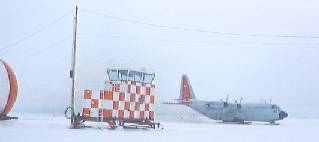 This picture shows the portable control tower at Willies Field.
The red and white dome to the left houses the radar. All equipment is portable
and can be unplugged and towed to whichever air field is being used. The power
for all the facilities comes from large portable generators and the whole facility
is set up like a small town.
This picture shows the portable control tower at Willies Field.
The red and white dome to the left houses the radar. All equipment is portable
and can be unplugged and towed to whichever air field is being used. The power
for all the facilities comes from large portable generators and the whole facility
is set up like a small town.
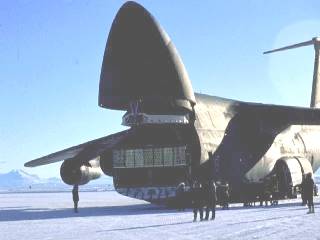
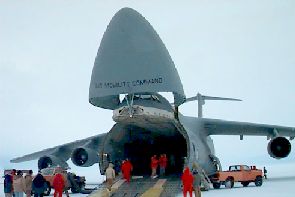
The C5 (Galaxy) is used once or twice a season, if at all. Its cost is prohibitive unless it is used in a joint function e.g. training of pilots. It can carry very bulky and heavy loads. I'm told that the engines are never shut down on this aircraft when its on the ice, in case they have to move it in a hurry. It's allowed to deflect the ice up to 175 millimeters before the panic buttons are pushed, and they have to move the aircraft or take off. You can see that this plane is loaded from the front and in the right hand photo the ramp is lowered. The whole thing actually lowers down on its landing gear to get closer to the ground for easier loading and unloading. Which is something you don't notice until you stand right beside it.
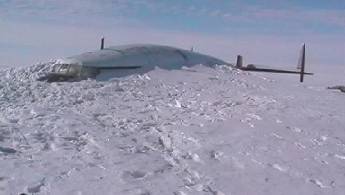 This is an old Constellation aircraft which crashed years ago
and was towed off to the side of the Pegasus runway. Its used as a tourist attraction
nowadays. Even the penguins have even been known to go out and have a look at
it from time to time. Another few years and it will become totally covered.
Ive heard that South Pole has a similar crashed plane which they use as a tourist
destination.
This is an old Constellation aircraft which crashed years ago
and was towed off to the side of the Pegasus runway. Its used as a tourist attraction
nowadays. Even the penguins have even been known to go out and have a look at
it from time to time. Another few years and it will become totally covered.
Ive heard that South Pole has a similar crashed plane which they use as a tourist
destination.
 Helicopters. One of my favorite forms of
transport. The green helo is a Iroquois which is the single
engine version of the Hughes 212 (twin engine Huey). The green
one belongs to the Royal New Zealand Air Force (RNZAF), while the
red one is flown by an American contractor, PHI. The helo hours
are pooled, being used by Scott Base and McMurdo and the numerous
field events.
Helicopters. One of my favorite forms of
transport. The green helo is a Iroquois which is the single
engine version of the Hughes 212 (twin engine Huey). The green
one belongs to the Royal New Zealand Air Force (RNZAF), while the
red one is flown by an American contractor, PHI. The helo hours
are pooled, being used by Scott Base and McMurdo and the numerous
field events.
The New Zealand pilots are
interesting to fly with and can be very creative when getting
from point A to point B. Anyone who has flown with the men and
women of the RNZAF will know what I mean.
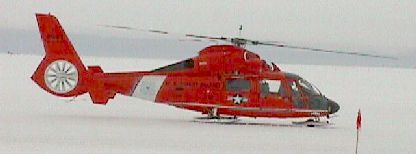
This is the coast guard
Dalphine Helicopter. Fast, but
limited in weight carrying ability and a bit delicate compared to
others of similar size. The tail
rotor is susceptible to damage from foreign objects damaging the
blades and was damaged while in antarctica this year (1998).
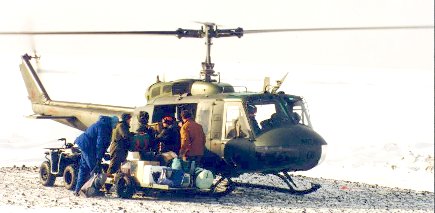
The Kiwi helo normally has two pilots and a load master who loads and unloads passengers and equipment. The Americans have one pilot and passengers load their own equipment. The Americans also run helicopters called "Astar's" which are very not so big as the Hueys, but are fine for smaller loads and general running around. This is a typical loading of a Helicopter outside Scott Base on one of the two Helo Pads. Before approaching the helicopter you have confirm through a positive eye contact and thumbs up from the pilot that it is safe to enter within the danger zone of the spinning blades. Always entering from the front of the Helicopter and never going near the spinning tail rotor blade. One of the small 4 wheel motor bikes is used to take the trailer full of gear out to the landing pad.
Running costs for a NZ Huey per hour = about $2000 NZ dollars ($1.00 NZ =$0.55 US as at 29-3-98)
Running costs for an American Huey per hour = about $2800 NZ dollars . (These are only approximate costs. )
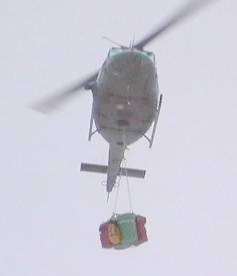 This Iroquois is carrying an under slung load. If the load to
be carried is too large ( in size not weight) or has hazardous material, then
it is carried under the helo, a very common practice.
This Iroquois is carrying an under slung load. If the load to
be carried is too large ( in size not weight) or has hazardous material, then
it is carried under the helo, a very common practice.
Kiwis have a reputation for taking on jobs which the American pilots are not allowed to take. The American pilots are, however, more experienced with a greater number of flying hours. A Kiwi pilot observed: "the Kiwis pack a greater variety into less flying hours", and so it all balances out; or so
The helicopters down here are fitted with special brakes that are used to slow the rotor when they want to come to a complete stop. They have this modification because the low humidity of the Antarctic air does not provide enough air resistance for the blades to stop quickly when winding down.
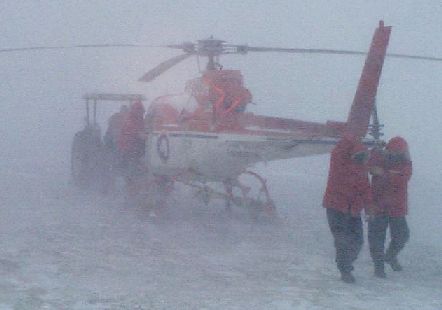
The Americans packing away one of the helo's into the shed as a storm picks up.
www.geocities.com/coolrunnernz/
9-3-01
Writen by Ray Young
Edited by Shirley Baston Fred - [email protected] - ICQQ # 15167279